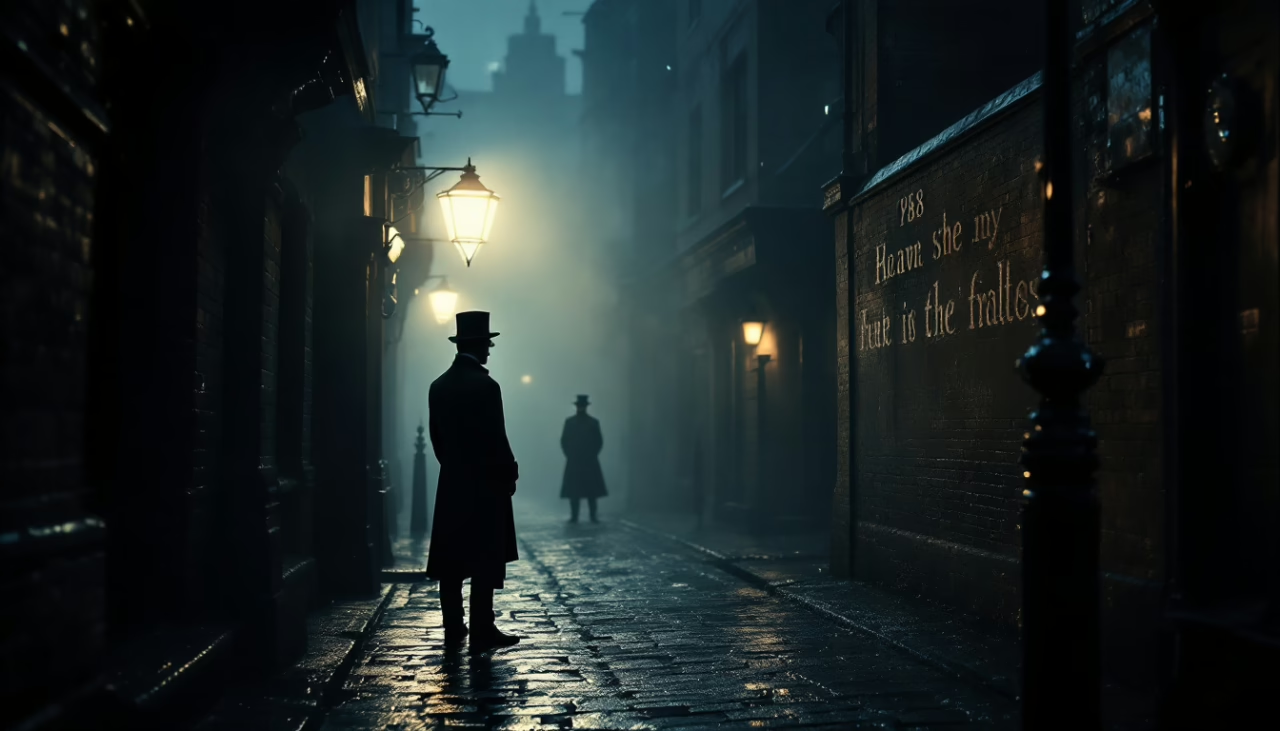The Mystery of Jack the Ripper: Identity, Facts, Victims, and Suspects

Who Was Jack the Ripper? A Cold Case Revisited – The autumn of 1888 transformed London’s East End into a landscape of terror.
Against the backdrop of fog-shrouded cobblestone streets, an unknown predator stalked women with surgical precision, leaving a trail of brutality that confounded investigators and ignited public hysteria.
The Ripper’s identity vanished into history’s shadows, yet his legend persists through time. Was he a surgeon, a butcher, or someone beyond imagining?
The answers may lie scattered among faded police reports, whispered theories, and the silent testimony of Whitechapel’s dark corners.
Principal Conclusions
Hide- Jack the Ripper murdered five women in London's Whitechapel district during 1888, targeting primarily female prostitutes.
- Despite extensive investigations, the killer's identity remains unknown, spawning countless theories about potential suspects.
- The Ripper's victims were Mary Ann Nichols, Annie Chapman, Elizabeth Stride, Catherine Eddowes, and Mary Jane Kelly.
- Prime suspects included butcher George Chapman, surgeon Sir William Gull, and artist Walter Sickert.
- The murders were characterized by increasing brutality, surgical precision, and a lack of conclusive evidence.
Whitechapel, 1888: London Gripped by Fear

London’s East End, particularly Whitechapel, existed as a domain of profound destitution in 1888, where the Victorian prosperity that defined other parts of the metropolis seemed a distant mirage for its impoverished inhabitants.
The emergence of a methodical killer who targeted women in this neglected district transformed the already bleak atmosphere into one of palpable terror, as gas-lit streets became empty after dark and neighbors regarded one another with newfound suspicion.
What had been merely a forgotten corner of the Empire’s greatest city suddenly occupied the horrified attention of all London, as citizens from every social stratum found themselves collectively holding their breath, wondering where—and when—the shadowy figure known only through his gruesome handiwork might strike again.
A City on Edge in the Late Victorian Era
Whitechapel in 1888, a district already notorious for its crime-infested slums and desperate poverty, became the perfect hunting ground for history’s most infamous serial killer.
The social fabric of London’s East End was frayed by extreme economic inequality, where Victorian prosperity existed in stark contrast to neighborhoods where prostitution, robbery, and violence were constant companions to those struggling to survive.
As the Ripper’s murders intensified, so too did public anxiety transform into collective hysteria, creating a climate of suspicion where neighbors eyed one another warily in the fog-shrouded streets and women feared to venture out alone after dark.
The social climate in East End London
Fear crept through the cobblestone streets of late Victorian East London like an insidious fog, transforming ordinary shadows into potential harbingers of doom.
The area epitomized social inequality, with immigrant communities packed into squalid tenements where public health crises flourished unchecked.
Local governance proved woefully inadequate in addressing these conditions, while rudimentary crime prevention measures failed to protect society’s most vulnerable members.
Crime, poverty, and public unease
By autumn of 1888, the dimly lit streets and narrow alleyways of Whitechapel had transformed into something far more sinister than mere urban blight—they had become hunting grounds.
Crime statistics revealed the East End’s harrowing reality: social unrest festered amid staggering poverty impact. Urban decay manifested physically and morally, leaving public health in shambles while residents navigated a precarious existence between desperation and the constant shadow of violence.
The Emergence of a Killer in the Shadows
The discovery of Mary Ann Nichols’s mutilated body on August 31, 1888, in Buck’s Row marked the first official Ripper murder, though few initially recognized it as the beginning of what would become London’s most infamous killing spree.
Metropolitan Police, overwhelmed by the area’s endemic crime and lacking modern investigative techniques, initially treated the case as yet another East End homicide, with Inspector Frederick Abberline only later being assigned to coordinate the increasingly complex investigation.
As autumn shadows lengthened across Whitechapel’s narrow lanes, both authorities and citizens remained unaware that this single act of violence heralded the emergence of a killer whose methods would grow increasingly brutal and whose identity would confound generations.
First signs that something sinister was unfolding
Although London had experienced its share of violent crimes throughout its history, something distinctly malevolent began to materialize in the narrow, fog-shrouded streets of Whitechapel during the spring and summer of 1888.
Unusual sightings of shadowy figures and local whispers of escalating violence created community fears. Unsettling patterns of petty crime evolved into more sinister incidents, while early warnings from concerned citizens went largely unheeded by authorities.
Police response to the first murder
Responding swiftly but inadequately to the discovery of Mary Ann Nichols‘ mutilated body on August 31, 1888, Metropolitan Police officers descended upon Buck’s Row in Whitechapel with a mixture of professional detachment and undisguised bewilderment.
Initial eyewitness accounts proved frustratingly sparse, while forensic techniques limitations hampered meaningful evidence collection.
Police investigation strategies centered on neighborhood canvassing rather than systematic analysis, with public safety measures primarily consisting of increased patrols—decisions later scrutinized through media influence analysis.
The Canonical Five: Lives Cut Short
The canonical five victims of Jack the Ripper—Mary Ann Nichols, Annie Chapman, Elizabeth Stride, Catherine Eddowes, and Mary Jane Kelly—represent the human tragedy at the heart of London’s most infamous murder spree.
Each woman, struggling at society’s margins in Whitechapel’s impoverished streets, met her end through exceptionally brutal means between August and November 1888, their stories forever entangled with their killer’s macabre legacy.
Their lives, often reduced to footnotes in the sensational hunt for the Ripper, deserve examination not merely as victims but as individuals whose paths through Victorian London’s unforgiving landscape ultimately intersected with one of history’s most notorious killers.
Mary Ann Nichols: The First Known Victim
Mary Ann Nichols, discovered in Buck’s Row (now Durward Street) at approximately 3:40 a.m. on August 31, 1888, marked the beginning of the Ripper’s murderous campaign in Whitechapel.
The post-mortem examination, conducted by Dr. Rees Ralph Llewellyn and later by Dr. George Bagster Phillips, revealed her throat had been severed by two distinct cuts, while her abdomen suffered multiple deep, jagged incisions that suggested both violence and a disturbing level of anatomical knowledge.
These wounds—particularly the abdominal mutilations that exposed her intestines—established the signature brutality that would come to characterize the Ripper’s subsequent victims and confound investigators for generations to come.
Location and timing of the murder
Shortly before 3:40 a.m. on August 31, 1888, amid the fog-shrouded streets of London’s impoverished Whitechapel district, Mary Ann Nichols met her tragic end at the hands of a killer who would soon terrorize the city.
Her body was discovered in Buck’s Row (now Durward Street), establishing the first point in what would become a disturbing pattern of murder locations and timing—predominantly during weekends or holidays.
Medical examination and key findings
When Dr. Rees Ralph Llewellyn examined Nichols’ body, his pathological analysis revealed the brutal nature of the attack, illuminating essential forensic techniques of the Victorian era within their historical context.
- Throat severed by two distinct cuts, exposing the vertebrae
- Abdominal mutilations suggesting anatomical knowledge
- Absence of significant blood at the scene, indicating the victim was killed elsewhere
Annie Chapman: Struck in the Early Morning
Annie Chapman’s brutalized body was discovered shortly after 6 a.m. on September 8, 1888, in the backyard of 29 Hanbury Street, a crowded lodging house in Spitalfields.
Investigators were particularly disturbed by the methodical nature of the crime scene, where Chapman’s possessions—including her meager effects of pills, a piece of envelope, and a comb—had been arranged neatly by her feet in stark contrast to the violence inflicted upon her body.
The surgical precision with which certain organs had been removed suggested to medical examiners that the killer possessed anatomical knowledge, a detail that would greatly influence the direction of the Ripper investigation and spark theories about the murderer’s background that persist to this day.
Discovery behind 29 Hanbury Street
At approximately 6:00 AM on September 8, 1888, the backyard of 29 Hanbury Street became the site of a gruesome discovery that would further cement London’s fear of the killer who would later be known as Jack the Ripper.
- Market porter John Davis stumbled upon Chapman’s mutilated body in the narrow passage between houses.
- The crime scene revealed surgical precision: her intestines placed over her shoulder, several items arranged at her feet.
- Residents of the overcrowded tenement reported hearing nothing despite the brutality that unfolded mere yards from their beds.
Details that shocked the investigators
Horrifying even the most seasoned detectives, the details surrounding Annie Chapman’s murder revealed a level of calculated brutality that transcended ordinary homicide.
Early forensic advancements struggled to comprehend the surgical precision evident in her mutilation, while primitive psychological profiles attempted to make sense of such depravity.
Media influence shaped public perception, transforming investigative techniques from methodical inquiry into desperate measures against an invisible predator.
Elizabeth Stride: Interrupted by a Witness?
Elizabeth Stride’s murder stands apart from the Ripper’s other victims primarily because her killer may have been interrupted mid-attack, leaving her with only a single throat slash rather than the extensive mutilations characteristic of his other crimes.
The rain-soaked crime scene in Dutfield’s Yard complicated investigative efforts, washing away potential evidence and creating challenges for police attempting to gather forensic details in the dimly lit alleyway.
This interruption, possibly by Louis Diemschutz who discovered her body still warm, suggests a critical moment when the Ripper’s ritualistic killing process was thwarted, leading some researchers to question whether this murder truly fits the canonical pattern or represents an incomplete Ripper signature.
Differences from other murders
Unlike the other canonical Ripper murders, which followed a grimly predictable pattern of escalating mutilation, the killing of Elizabeth Stride stands apart due to compelling evidence suggesting the killer was interrupted mid-attack.
- Her throat was cut, but her body lacked the extensive abdominal mutilations characteristic of investigative methods employed in other cases.
- Media sensationalism focused on this “incomplete” murder, fueling urban legends about a thwarted killer.
- Victim profiling and public perception shifted, suggesting the killer’s evolving methodology or possible witness intervention.
Significance of the rain-soaked crime scene
The rain-soaked cobblestones of Dutfield’s Yard, glistening under the feeble glow of distant gas lamps, preserved crucial forensic evidence that modern investigators would have meticulously documented but which Victorian authorities largely overlooked.
The weather conditions greatly complicated investigative challenges, washing away blood patterns and footprints.
These rain effects altered the crime scene irreparably, creating historical implications for understanding the Ripper’s methodology and movements.
Catherine Eddowes: Killed the Same Night
Catherine Eddowes’ murder scene yielded far more investigative material than that of Elizabeth Stride, with vital evidence discovered near Mitre Square pointing toward the killer’s movements.
A portion of Eddowes’ bloodstained apron, torn from her body, was found in nearby Goulston Street, suggesting the Ripper’s escape route through Whitechapel’s shadowy passages.
Above this grim discovery, written in chalk on a wall, was the cryptic message “The Juwes are not the men that will be blamed for nothing,” which police controversially erased before daybreak, fearing anti-Semitic riots in an already tense East End.
Clues left near Mitre Square
Mystery permeated the cobblestoned streets surrounding Mitre Square on the morning of September 30, 1888, as investigators discovered several cryptic items that would become essential evidence in the Ripper investigation.
The forensic evidence collected during the meticulous police investigation near Catherine Eddowes’ crime scene included witness accounts of a mysterious figure departing the area.
- A blood-stained piece of Eddowes’ apron found in Goulston Street
- Chalk-written graffiti on a nearby wall reading “The Juwes are not the men that will be blamed for nothing”
- A leather apron discovered near a water spout, initially causing public speculation
The torn apron and the cryptic graffiti
Among history’s most chilling pieces of crime scene evidence, the torn fragment of Catherine Eddowes‘ apron discovered in Goulston Street stands as a macabre breadcrumb deliberately left by the Ripper after her brutal murder on September 30, 1888.
Above this bloodstained cloth, cryptic graffiti reading “The Juwes are not the men that will be blamed for nothing” sparked numerous investigative theories and urban legends regarding symbolic messages left by the killer.
Mary Jane Kelly: The Most Brutal Killing
Mary Jane Kelly, discovered on November 9th, 1888, in her small room at Miller’s Court, represents the Ripper’s final canonical victim and most horrific crime scene.
Unlike the previous outdoor killings, the privacy of Kelly’s lodgings allowed the murderer unprecedented time with his victim, resulting in mutilations so extensive that even the experienced coroner, Dr. Thomas Bond, expressed shock at their savagery in his official report.
The brutal dismemberment of Kelly’s body, including the removal of internal organs and facial features, marked a disturbing escalation in violence that has continued to haunt criminologists and historians for over a century.
Her room at Miller’s Court
The humble lodgings at 13 Miller’s Court would become the stage for Jack the Ripper’s most horrific tableau, a cramped single room measuring merely 12 feet by 12 feet where Kelly spent her final days.
- Spartan furnishings included a bed, table, and two chairs—a meager backdrop for such historical infamy.
- Kelly decorated her walls with cheap prints and photographs, humanizing touches in an otherwise bleak space.
- The single window, through which her killer likely observed her, remained partially curtained for minimal privacy.
The mutilation that stunned even the coroner
Horror permeated the atmosphere at 13 Miller’s Court on November 9, 1888, when authorities discovered what would become Jack the Ripper‘s most grotesque crime scene.
The coroner, accustomed to murder investigation techniques of the era, was visibly shaken by Kelly’s mutilation—her body eviscerated beyond recognition.
This slaughter highlighted the primitive forensic advancements history desperately needed, while media influence sensationalism fueled public terror, creating lasting societal impacts crime scholars still analyze today.
Other Possible Victims
While the Canonical Five victims remain the most firmly established in Ripper lore, historians and criminologists have long debated whether Jack’s bloody tally extended beyond this acknowledged roster.
The question of additional victims hinges on the distinctive characteristics that define a Ripper murder—specifically the particular pattern of mutilations, the geographical proximity to Whitechapel, and the timing of the crimes within the autumn of terror.
These contested cases, including victims like Martha Tabram and Frances Coles, illuminate the methodological challenges inherent in retrospective forensic analysis and reveal how the boundaries of this historical case continue to shift with each new generation of researchers.
Were There More Than Five?
Modern experts have expanded their analysis beyond the canonical five victims to include several other potential Ripper murders, creating a more complex portrait of the killer’s possible range.
The cases of Emma Smith and Martha Tabram, both brutally attacked in Whitechapel during 1888, generate particular scholarly interest, with Smith’s April assault and Tabram’s August stabbing representing chronological bookends that might frame the Ripper’s escalating violence.
These contested cases reflect the fundamental challenge of Ripper historiography: determining which murders truly belong to the same hand requires maneuvering through fragmentary evidence, inconsistent police records, and the methodological question of what constitutes a signature killing in an era before modern forensic understanding.
Cases considered by modern experts
Scholars continue to debate whether Jack the Ripper‘s infamous tally extended beyond the canonical five victims, scrutinizing historical records for overlooked connections that might expand our understanding of his murderous campaign.
Modern analysis has transformed these historical investigations, with expert opinions drawing upon advanced forensic techniques to reconsider previously dismissed cases within their proper psychological and historical context.
- Martha Tabram’s August 1888 stabbing bears signature elements of controlled violence
- Emma Smith’s April 1888 assault potentially represents an early, less refined attack
- Frances Coles’ 1891 Thames murder exhibits the Ripper’s evolved methodology
Debate over Emma Smith and Martha Tabram
Although the canonical five victims remain the cornerstone of Ripper historiography, the puzzling cases of Emma Smith and Martha Tabram continue to challenge definitive conclusions about the killer’s true body count.
The murder similarities—brutal attacks on impoverished women in Whitechapel’s shadowy corners—align with established victim profiles, yet essential differences in methodology persist.
Their historical significance lies in expanding our understanding of Victorian London’s perilous landscape.
What Defines a Ripper Killing?
Jack the Ripper’s murders are distinguished by a specific constellation of characteristics—extreme violence toward the throat, abdominal mutilations with organ removal, and victims who were typically impoverished women of the Whitechapel district.
Many contemporary deaths exhibited some but not all of these hallmarks, leading researchers to exclude them despite their temporal and geographical proximity to the canonical five victims.
The boundaries of what constitutes a “Ripper killing” remain contested ground among criminologists and historians, with the definition directly influencing both the perceived timeline and psychological profile of London’s most notorious killer.
The killer’s method and pattern
Slashing through the fabric of Victorian London’s East End, the murderer’s methodology established a grim signature that criminologists still study today.
Jack’s psychological profile emerges through his victim selection—predominantly impoverished prostitutes—and forensic analysis of crime scenes revealing calculated brutality.
- Victims killed in public yet secluded locations
- Progressive mutilation pattern, suggesting evolving confidence
- Surgical precision in organ removal, hinting at anatomical knowledge
Why some deaths are still excluded
Why do scholars exclude certain Victorian-era murders from the canonical list of Jack the Ripper killings?
Victim categorization challenges arise from inconsistent wound patterns and geographic anomalies, while historical context relevance demands consideration of London’s broader criminal landscape.
Media influence analysis reveals how contemporary newspapers shaped public perception, modern investigative techniques reexamine evidence, and Ripperology debates continue regarding which deaths truly belong to the Whitechapel murderer’s blood-soaked legacy.
Messages, Letters, and Clues
The Ripper case produced a trove of mysterious communications that continue to fascinate criminologists and historians alike, most importantly the taunting “Dear Boss” letter that introduced the moniker “Jack the Ripper” to the public consciousness.
Another chilling piece of correspondence, the “From Hell” letter, arrived with a preserved human kidney, purportedly taken from victim Catherine Eddowes, raising questions about the killer’s medical knowledge and psychological state.
Beyond written communications, cryptic markings and graffiti appeared near crime scenes, including the infamous chalk inscription on Goulston Street that some researchers believe contained coded messages or clues to the killer’s identity.
The “Dear Boss” Letter and Its Impact
The infamous “Dear Boss” letter, received by London’s Central News Agency on September 27, 1888, marked the first appearance of the now-legendary moniker “Jack the Ripper,” forever branding the unidentified killer with a name that would echo through centuries of criminal history.
Victorian London’s newspapers, desperate for circulation in an era of heightened competition, reproduced the letter’s chilling contents with sensational headlines, transforming a local East End murder spree into an international phenomenon that gripped the public imagination.
The widespread coverage not only fueled unprecedented panic throughout London but also established a template for media treatment of serial killers, demonstrating how a murderer’s own words—whether authentic or fabricated—could shape public perception and dictate the narrative of their crimes.
The first use of the name “Jack the Ripper
Although many aspects of the Whitechapel murders remain shrouded in mystery, historians can pinpoint with remarkable precision the moment when the killer acquired his infamous moniker.
The name “Jack the Ripper” first emerged in the sensational “Dear Boss” letter received by London’s Central News Agency on September 27, 1888, igniting an unprecedented media frenzy and cementing the murderer’s place in historical context.
- First reports of the “Dear Boss” letter transformed public discourse about the murders
- Media outlets across London amplified the name’s impact, spreading fear through all social classes
- Original name origin became a macabre cultural touchstone, reflecting Victorian anxieties about urban dangers
Public reaction and media coverage
Few historical documents have shaped public imagination as powerfully as the infamous “Dear Boss” letter, transforming an already sensational series of murders into a cultural phenomenon that transcended its Victorian origins.
The Media Sensation surrounding Jack the Ripper created unprecedented Public Panic, with newspapers exploiting Sensationalism Effects for profit, raising questions about Reporting Ethics while demonstrating Media Influence in constructing public narratives of crime.
“From Hell” and the Kidney Package
Unlike the theatrical “Dear Boss” letter, the infamous “From Hell” note arrived with a human kidney specimen, purportedly from the murdered Catherine Eddowes, and displayed marked differences in handwriting, grammar, and overall tone—characteristics that have fueled both credibility arguments and suspicions among researchers.
The package’s macabre delivery to George Lusk, head of the Whitechapel Vigilance Committee, represented an escalation in the killer’s psychological warfare, though modern scholars question its authenticity based on incongruities in the medical evidence and the unusually direct communication style.
These discrepancies, coupled with the timing of its arrival amid heightened public hysteria, have led many Ripperologists to contemplate the possibility that the “From Hell” correspondence represented another cruel hoax rather than genuine communication from London’s most notorious murderer.
Differences in tone and handwriting
When examining the notorious correspondence attributed to Jack the Ripper, forensic linguists and historians have identified striking variations in both tone and handwriting that challenge the assumption of a single author behind these macabre communications.
Psychological profiling suggests multiple personalities—or perhaps multiple writers—engaged in this letter authenticity debate.
- Handwriting analysis reveals inconsistent penmanship skills across different letters
- Tone comparison shows dramatic shifts from clinical detachment to manic glee
- Communication methods varied between carefully constructed threats and hastily scrawled notes
Why this note is viewed with suspicion
Among the most infamous items in the Ripper case archive, the “From Hell” letter and its accompanying half-kidney package represent perhaps the most disturbing yet dubious communication attributed to the Whitechapel murderer.
The suspicious notes and cryptic messages lack forensic analysis verification, while historical context and witness accounts suggest police skepticism.
Many criminologists question its authenticity, noting inconsistencies with other communications and potential hoax elements.
Graffiti, Chalk, and Mysterious Marks
One of the most controversial pieces of evidence in the Ripper case emerged on Goulston Street, where police discovered a chalk-written message above a bloody piece of fabric belonging to victim Catherine Eddowes.
The graffiti, reading “The Juwes are the men that will not be blamed for nothing,” was hastily erased on orders from Commissioner Sir Charles Warren, who feared anti-Semitic riots would erupt if the public saw it.
This contentious decision sparked enduring debate among Ripperologists about whether the message was genuinely connected to the killer or merely coincidental, with some theorizing it represented a deliberate attempt to inflame ethnic tensions while others suggest it offered a cryptic clue to the murderer’s identity or motivations.
Goulston Street and the erased message
After the murder of Catherine Eddowes on September 30, 1888, investigators discovered what may have been the killer’s most tantalizing clue in the form of a cryptic chalk inscription on a wall in Goulston Street.
- The message “The Juwes are not the men that will be blamed for nothing” carried profound historical implications.
- Metropolitan Police Commissioner Sir Charles Warren personally ordered its erasure before dawn.
- Debate over this decision’s cryptic significance continues to fuel police theories today.
Theories on the intent behind it
The message discovered on Goulston Street has generated numerous theories regarding its author’s intentions, with scholars debating whether it represented a genuine clue from the Ripper himself or merely an unfortunate coincidence of timing and location.
Modern psychological profiling suggests either calculated misdirection or a manifestation of deep-seated rage, while the historical context of anti-Semitism adds complex societal implications to criminal psychology and motive analysis.
Suspects That Still Haunt the Case
The hunt for Jack the Ripper‘s true identity continues to captivate historians and armchair detectives more than a century after his bloody spree through Whitechapel‘s fog-shrouded streets.
Among the numerous suspects, several figures emerge repeatedly in the historical record: a mentally disturbed Polish barber, a barrister who met a watery end, an eccentric artist with anatomical knowledge, a controversial royal, and a cast of lesser-known individuals whose potential guilt has faded into historical obscurity.
These shadowy figures, each with their own incriminating circumstances and alibis, represent the enduring mystery at the heart of history’s most infamous unsolved murder case.
Aaron Kosminski: The Barber with a Dark Past
Police officials in the Ripper investigation believed Kosminski exhibited increasingly deranged behavior, noting his misogynistic tendencies and documented mental instability, which ultimately led to his confinement in an asylum.
Modern DNA analysis conducted on a shawl purportedly linked to Catherine Eddowes’s murder suggested Kosminski’s involvement, though the chain of evidence preservation remains problematic, raising serious questions about contamination over the century-plus interval.
The limitations of these genetic tests—including concerns about the shawl’s provenance, handling procedures across generations, and the impossibility of conclusively matching partial DNA profiles—illustrate the frustrating nature of forensic investigation in historical cases where time has degraded both evidence and certainty.
What police believed about his behavior
Several prominent investigators believed Aaron Kosminski displayed behaviors consistent with their developing profile of Jack the Ripper, noting his misogynistic tendencies and increasingly erratic conduct in the Whitechapel district.
Early criminal profiling and behavioral analysis of his psychological state revealed:
- Extreme aversion to women that manifested in violent outbursts
- Paranoid delusions documented in police and asylum records
- Nocturnal habits that aligned with the Ripper’s killing pattern
Modern DNA tests and their limitations
Numerous modern DNA analyses have attempted to conclusively link Aaron Kosminski to the Ripper murders, most notably the controversial 2019 study that examined genetic material from a shawl allegedly found at Catherine Eddowes’ murder scene.
Despite forensic advancements in genetic sequencing, these findings face substantial criticism regarding evidence contamination, historical accuracy of the artifacts tested, and ethical considerations surrounding both methodology and conclusive declarations about century-old crimes.
Montague John Druitt: The Suicidal Barrister
Montague John Druitt, a 31-year-old barrister and part-time teacher, became a prime suspect when his body was discovered floating in the Thames on December 31, 1888—merely a month after the final canonical Ripper murder.
His suicide coincided suspiciously with the cessation of the killings, compelling Chief Constable Melville Macnaghten to name him as the “most likely” suspect in his 1894 memorandum.
The timing of events, combined with cryptic family suggestions about his “mental instability” and subsequent dismissal from his teaching post shortly before his death, cemented Druitt in the annals of Ripper investigation despite the absence of concrete evidence connecting him to the Whitechapel crimes.
Timeline surrounding his death
Although widely considered among the most compelling Jack the Ripper suspects, Montague John Druitt‘s life ended in circumstances as mysterious as the crimes he may have committed.
The death timeline reveals significant connections to the Whitechapel murder investigation milestones and victim profiles.
- Found floating in Thames on December 31, 1888 – approximately one month after final canonical murder
- Dismissed from teaching position in key events preceding suicide
- Coroner’s report noted “serious trouble” and “mental derangement”
Why police at the time considered him
Druitt’s tragic end by suicide represents just one piece of the puzzle that led Victorian investigators to regard him a prime suspect in the Whitechapel murders.
His proximity to the crime scenes, coupled with the cessation of killings after his death, shaped both investigative methods and public perception.
Criminal profiling techniques, though primitive by modern standards, identified disturbing parallels between Druitt’s psychological state and the societal impact of the murders.
Walter Sickert: The Artist in the Spotlight
Walter Sickert, a prominent Victorian artist and contemporary of the Ripper murders, became a controversial suspect decades after the crimes when researchers claimed to identify connections between his artwork and the killings.
His paintings of nudes in dingy Camden Town lodgings, particularly those depicting reclining women in poses eerily reminiscent of the victims’ positions, have been scrutinized for potential hidden confessions or knowledge of the crimes.
Handwriting analysts have further fueled speculation by suggesting similarities between Sickert’s script and that found in letters purportedly sent by the Ripper, though many scholars dismiss these connections as coincidental or methodologically flawed.
Claims made decades later
Among the most enigmatic figures to emerge in the decades-long search for Jack the Ripper‘s identity stands Walter Sickert, a prominent British impressionist painter whose name became entangled with the Whitechapel murders through a series of posthumous claims.
Forensic advancements have both supported and refuted these evolving theories, shaping public perception within shifting historical contexts.
- Sickert’s dark, brooding paintings depicting Victorian London’s seedy underbelly
- Author Patricia Cornwell’s controversial 2002 investigation claiming DNA evidence
- Letters and artistic works analyzed by modern scholars seeking psychological connections
Arguments from handwriting to paintings
The evidence connecting Walter Sickert to the Ripper murders has long centered on two distinct yet complementary domains: handwriting analysis and artistic interpretation.
Forensic techniques applied to his correspondence revealed striking similarities to the killer’s letters, while psychological profiles derived from his paintings—particularly those depicting reclining female figures—sparked debates about his potential involvement.
Public perception remains divided on whether these artistic interpretations represent valid evidence or merely coincidental, macabre inspiration.
Prince Albert Victor: A Royal Conspiracy?
The alleged involvement of Prince Albert Victor, grandson to Queen Victoria, emerged from Sir Stephen Knight’s 1976 book, which constructed an elaborate conspiracy linking the murders to Masonic rituals and royal indiscretions.
Historical records, however, reveal a significant obstacle to this sensational theory: during several of the Whitechapel murders, the Prince was demonstrably elsewhere—attending functions in Scotland and Yorkshire, hundreds of miles from London’s blood-soaked cobblestones.
These geographical impossibilities, coupled with a complete absence of substantiating evidence, have led most serious Ripperologists to dismiss the royal connection as an enticing but ultimately unfounded narrative that persists more through cultural fascination with power than historical plausibility.
Origin of the royal family theories
Many enduring conspiracy theories surrounding Jack the Ripper’s identity emerged in the late 20th century, focusing on Prince Albert Victor, Duke of Clarence and Avondale, grandson of Queen Victoria and second in line to the British throne.
Royal bloodlines intertwined with public perception created a perfect storm for conspiracy theories with significant historical implications.
- First appeared in 1970s books suggesting a royal cover-up to protect the monarchy
- Gained traction through unsubstantiated claims of Prince Eddy’s mental instability
- Perpetuated despite contradictory evidence regarding the Prince’s whereabouts during murders
Problems with the timeline
Despite multiple attempts to link Prince Albert Victor to the Whitechapel murders, serious chronological inconsistencies undermine these royal conspiracy theories.
Timeline discrepancies emerge when comparing witness testimonies with the prince’s documented whereabouts; his absence from London during several killings renders his involvement implausible.
Murder patterns, when scrutinized alongside police procedures and evidence analysis, further dismantle the royal suspect theory.
Other Lesser-Known Contenders
Beyond the more prominent suspects like Prince Albert Victor, a constellation of lesser-known contenders continues to orbit the Ripper case, including Francis Tumblety, an American quack doctor with a collection of uteruses, and George Chapman, a Polish-born barber with proven homicidal tendencies.
The enduring presence of these peripheral suspects—some plausible, others fantastical—reflects both the case’s evidentiary limitations and humanity’s persistent fascination with unsolved mysteries.
Their continued inclusion on suspect lists, despite varying degrees of substantiating evidence, speaks to the fundamental incompleteness of the Ripper investigation, an investigative vacuum that scholars and amateur sleuths alike rush to fill with theories ranging from the methodical to the wildly speculative.
Francis Tumblety, George Chapman, and more
Shadows of suspicion continue to stretch beyond the well-known Ripper suspects, encompassing a catalog of historical figures whose potential culpability has tantalized researchers for generations.
Francis Tumblety’s documented misogyny and medical knowledge align with established Ripper motives, while George Chapman‘s poisoning expertise presents a darker possibility within the historical context.
- Tumblety theories center on his anatomical collection and presence in London during the murders
- Chapman connections emerge from his surgical background and violent temperament
- Suspect profiles reveal disturbing patterns that mirror the psychological imprint of the crimes
Why so many suspects remain on the list
The enduring fascination with Jack the Ripper’s identity has spawned a remarkable abundance of suspects whose names linger in the historical record, creating what criminologists might call an unusually oversaturated suspect pool.
This proliferation stems from complex intersections of investigative biases, media influence, and shifting psychological profiles, all viewed through a distorted historical context that makes objective assessment of suspect motivations nearly impossible for modern researchers.
Why Jack the Ripper Was Never Caught
The infamous Whitechapel murders remain unsolved due to a perfect storm of factors that converged during the autumn of 1888.
Media sensationalism created an atmosphere of fear that both hindered police work and elevated the killer to mythic status, while Victorian-era investigators, hampered by primitive forensic techniques and bureaucratic infighting, missed vital evidence that might have identified the perpetrator.
Perhaps most intriguing is the possibility that the Ripper simply ceased his activities, either through death, imprisonment for another crime, or relocation—leaving behind an enduring mystery that continues to captivate criminologists and amateur sleuths more than a century later.
The Role of Media and Public Hysteria
The Jack the Ripper case became as much a media phenomenon as a police investigation, with newspapers of the era transforming the murders into London’s first true crime sensation through exaggerated reporting and inflammatory headlines.
Periodicals like the Star and the Illustrated Police News competed fiercely for readers, publishing unverified theories, fabricated interviews, and sensationalized illustrations that muddied investigative waters while stoking public terror.
This media frenzy not only complicated police efforts by generating countless false leads and unsubstantiated tips but also established a template for how serial killers would capture public imagination for generations to come.
How newspapers shaped the case
Why did Victorian newspapers transform a series of brutal murders into a media sensation that ultimately hindered the investigation? Media sensationalism dominated crime reporting, as newspapers competed fiercely for readership by embellishing details.
Journalistic ethics yielded to profit motives, drastically altering public perception of both victims and potential suspects.
- Penny dreadfuls and illustrated papers circulated gruesome woodcuts depicting imagined crime scenes
- Newspapers published hundreds of fake letters claiming to be from the killer
- Editors fabricated clues and theories that diverted police resources from legitimate investigation avenues
Sensational headlines and false leads
How dramatically did media-fabricated narratives derail the Ripper investigation?
Sensational journalism created a frenzy of false narratives, obscuring genuine evidence behind a veil of profitable hysteria.
Newspapers, prioritizing sales over accuracy, fueled public panic through lurid headlines and unverified “sightings.”
These investigative blunders diverted police resources toward phantom leads, allowing the actual perpetrator to elude justice amid the cacophony of misinformation.
Police Limitations and Missed Opportunities
The Victorian-era investigation into Jack the Ripper suffered greatly from jurisdictional rivalries between the City of London Police and Metropolitan Police, whose confusion and lack of coordination permitted vital evidence to fall through bureaucratic cracks.
Forensic limitations of the 1880s—before fingerprinting became standard practice, when photography at crime scenes remained rudimentary, and DNA analysis lay nearly a century in the future—hampered investigators’ ability to connect evidence scientifically to potential suspects.
Communication technology, restricted to handwritten messages and telegrams, further impeded the timely sharing of witness statements and crime scene observations, creating a fragmented investigative picture that the killer exploited to remain perpetually steps ahead of his pursuers.
Confusion between divisions
Two separate police divisions, operating with minimal coordination and burdened by bureaucratic rivalries, greatly hampered the Whitechapel murder investigations and contributed to Jack the Ripper’s ability to evade capture.
Division challenges created jurisdictional conflicts that repeatedly fragmented essential evidence across organizational boundaries.
- Metropolitan Police (H Division) and City of London Police maintained separate investigation files, creating information silos.
- Detectives often duplicated efforts, wasting precious resources on investigative overlaps.
- Communication barriers between divisions meant witnesses were sometimes interviewed multiple times, yielding inconsistent testimonies.
Forensic and communication challenges of the era
Victorian-era criminal investigations faced profound forensic limitations that virtually guaranteed Jack the Ripper’s anonymity, despite investigators’ diligence and growing public pressure for results.
The primitive investigative methods lacked fingerprinting, DNA analysis, and modern forensic techniques. Communication barriers between police divisions exacerbated challenges, while media influence heightened tensions through sensationalist reporting.
Public engagement manifested in both assistance and interference, contributing to the mystery that endures today.
Did the Killer Simply Stop?
One enduring mystery beyond the Ripper’s identity is why the brutal Whitechapel murders appeared to cease so abruptly after November 1888.
Criminologists have proposed three primary explanations for this sudden end: the killer may have died from illness or suicide, been imprisoned for an unrelated crime, or simply fled London to continue his murderous pursuits elsewhere.
These theories reflect the frustrating inconclusiveness of the case, where even the cessation of violence offers no definitive answers, merely more questions that echo through history’s darkened corridors.
Theories about why the murders ended
After the canonical five murders attributed to Jack the Ripper concluded in November 1888 with Mary Jane Kelly’s brutal slaying, criminologists and historians have proposed numerous theories about why the Whitechapel killings suddenly ceased.
The motive speculation extends beyond mere historical context into profound psychological considerations.
- Institutional commitment—the killer may have been imprisoned or committed to an asylum
- Death or emigration—the perpetrator might have died or fled abroad
- Psychological fulfillment—having satisfied his murderous impulses
Ideas around imprisonment, death, or escape
Among the most compelling explanations for Jack the Ripper’s sudden disappearance lies the possibility that the killer was imprisoned, died, or escaped London altogether.
Imprisonment theories suggest the murderer was incarcerated for unrelated crimes, while criminal psychology experts posit natural death or suicide as plausible endpoints.
Alternatively, historical justice may have been thwarted through elaborate escape routes, allowing the Ripper to evade the death penalties that would have surely awaited him.
Legacy of the Ripper
The Ripper’s shadowy legacy extends far beyond Victorian London, transforming both crime investigation and our cultural imagination. His brutal campaign catalyzed significant reforms in police methodology, including more systematic crime scene documentation, enhanced forensic techniques, and greater coordination between law enforcement agencies—innovations that would become standard practice in modern criminal investigation.
More than a century later, the Whitechapel murders continue to haunt our collective consciousness, inspiring countless books, films, and television series that grapple with the unsolved mystery and reflect society’s enduring fascination with the darkest aspects of human nature.
How the Case Changed Law Enforcement
The Jack the Ripper case fundamentally transformed British law enforcement, catalyzing considerable improvements in recordkeeping and forensic methodologies that would shape investigative procedures for generations to come.
Metropolitan Police officials, confronted with their investigative limitations during the Whitechapel murders, implemented more rigorous documentation systems and began exploring scientific approaches to evidence collection, including rudimentary fingerprinting and photography techniques that would later become standard practice.
Perhaps most considerably, the case exposed critical weaknesses in coordination between police divisions, prompting structural reforms that encouraged greater communication across jurisdictional boundaries, a legacy that continues to influence modern policing strategies worldwide.
Improvements in recordkeeping and forensics
Despite its gruesome nature, the Jack the Ripper case catalyzed substantial improvements in police recordkeeping and forensic methodology throughout London and beyond.
The investigation revolutionized how evidence and data were handled during criminal investigations, establishing protocols still relevant today.
- Introduction of systematic forensic advancements, including photography at crime scenes
- Development of standardized recordkeeping techniques for witness statements
- Implementation of more rigorous investigative methods for evidence collection and preservation
Coordination between divisions
Beyond the forensic advancements emerged perhaps the most significant institutional change in Victorian policing: unprecedented coordination between previously isolated divisions.
The Ripper investigation compelled Scotland Yard to reconsider historical policing methods that had long kept departments siloed, forcing improved inter-departmental communication despite entrenched collaboration challenges.
Investigative strategy alignment became essential across jurisdictions, though resource allocation issues frequently undermined these early efforts at systematic cooperation.
The Lasting Grip on Pop Culture
The Whitechapel murders remain firmly entrenched in popular culture, spawning hundreds of books and films that reimagine the killer’s identity, motives, and methods with varying degrees of historical accuracy.
This cultural immortality has birthed “Ripperology,” a quasi-academic pursuit where enthusiasts meticulously analyze every scrap of evidence, debating theories across online forums, conventions, and specialized publications with remarkable dedication.
The Ripper’s transformation from Victorian murderer to cultural icon demonstrates how unsolved mysteries capture public imagination, allowing each generation to project contemporary fears and fascinations onto the shadowy figure who continues to haunt our collective consciousness more than a century later.
Books, films, and ongoing fascination
Fascination with Jack the Ripper has transcended mere historical interest to become a cultural phenomenon that persists with remarkable tenacity more than a century after the Whitechapel murders.
The extensive body of Ripper literature, ranging from scholarly analyses to speculative fiction, alongside numerous cinematic adaptations, demonstrates our cultural obsession with unsolved mysteries that challenge our understanding of historical accuracy.
- Over 100 books examining the Ripper’s identity, including Alan Moore’s graphic novel “From Hell”
- Films like “The Lodger” (1927) and “Murder by Decree” (1979) that reimagine Victorian London’s shadowy underworld
- Annual conferences where independent researchers present new theories based on ongoing investigation
The rise of “Ripperology” and online communities
Modern technology has revolutionized the study of Jack the Ripper, giving birth to an informal discipline known as “Ripperology” and fostering lively online communities dedicated to solving history’s most infamous cold case.
These digital archives have transformed historical analysis, allowing enthusiasts to examine evidence collectively across continents.
Through sophisticated online discussions, theories evolution occurs organically as Ripperology communities debate, analyze, and occasionally unearth previously overlooked historical connections.
Wrapping Up
Jack the Ripper’s shadow still stretches across history like a dark fog that refuses to lift from London’s cobblestones.
The unsolved mystery continues to fascinate scholars, amateur sleuths, and the public alike, evolving from historical crime to cultural touchstone.
Perhaps the Ripper’s true legacy lies not in his identity but in how his crimes forever changed criminal investigation, media coverage, and our enduring fascination with the darkest corners of human nature.





